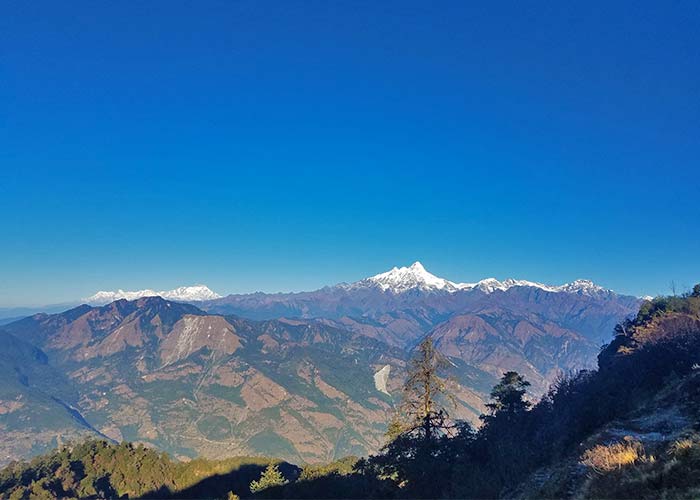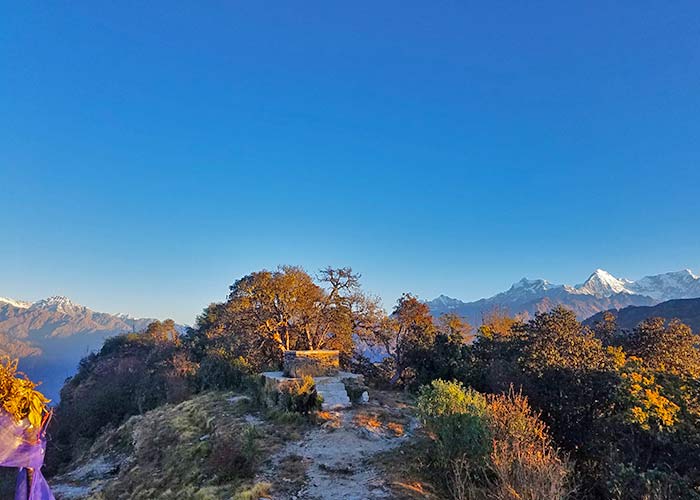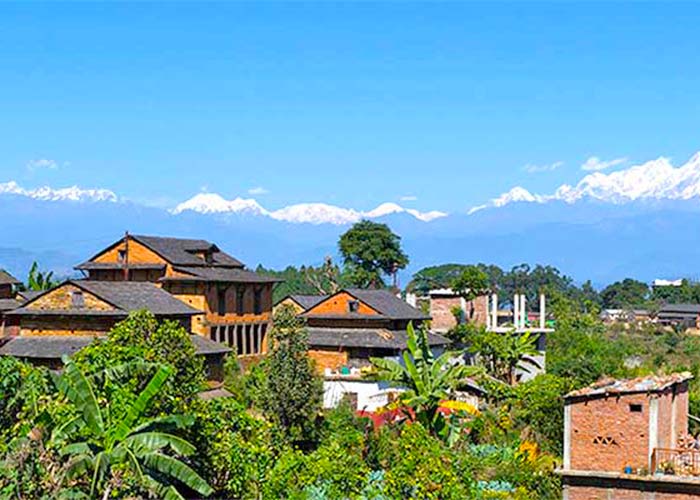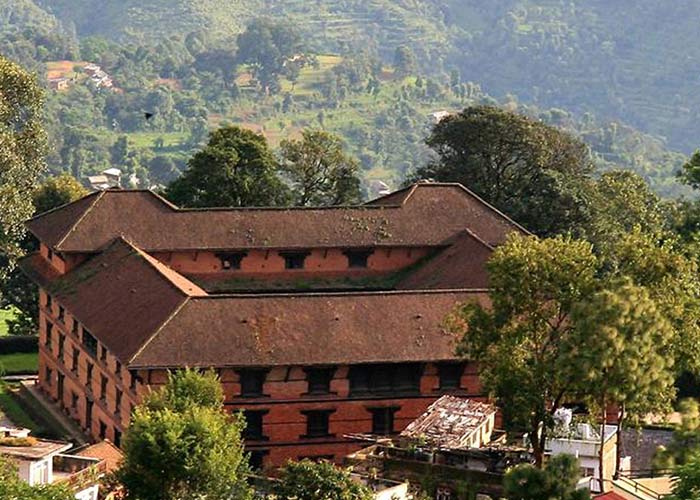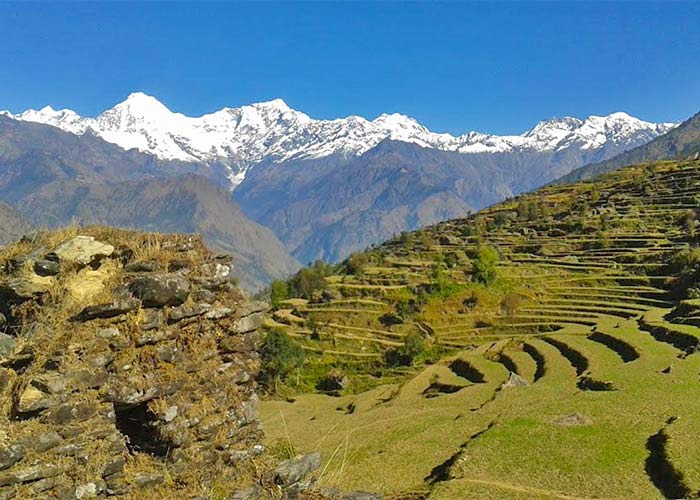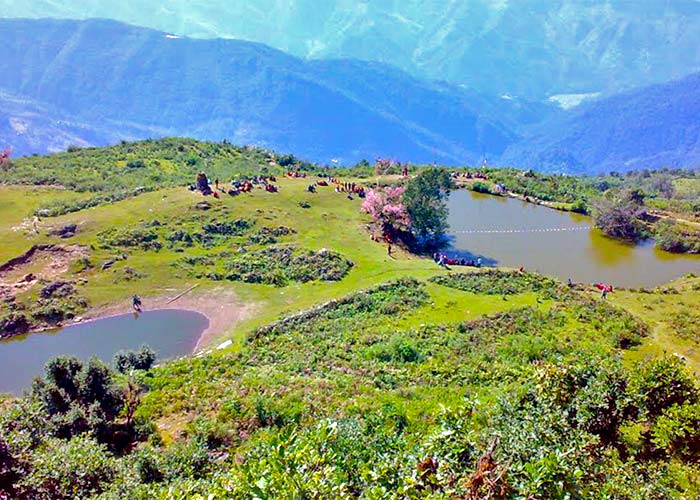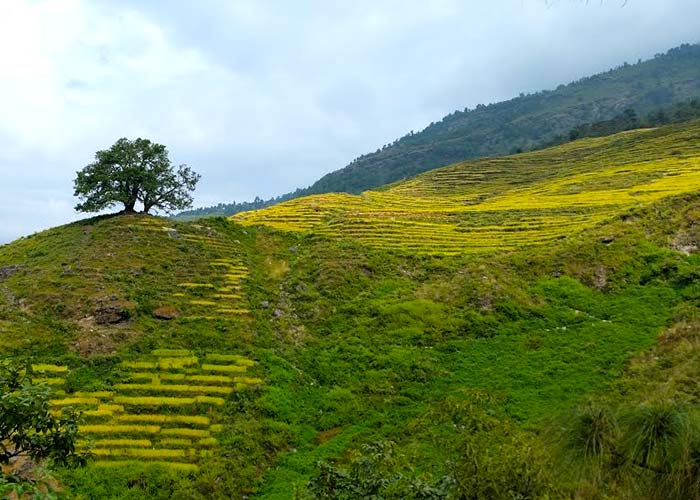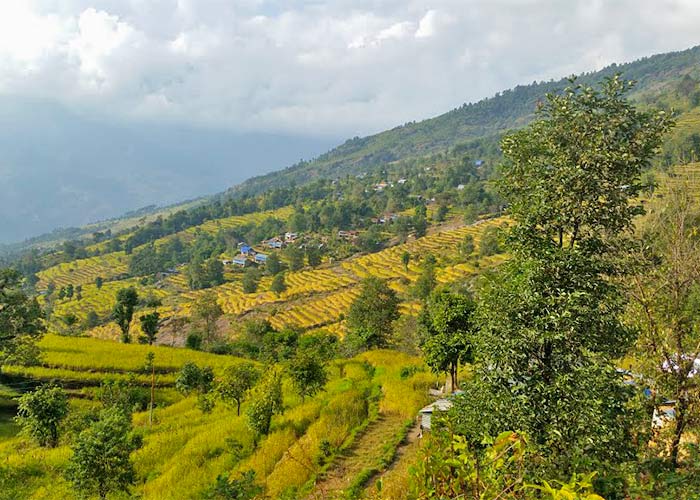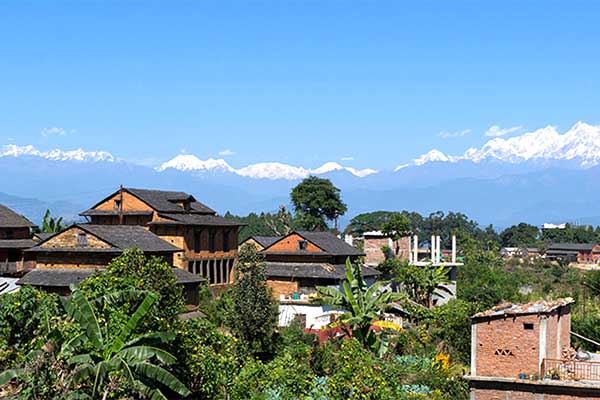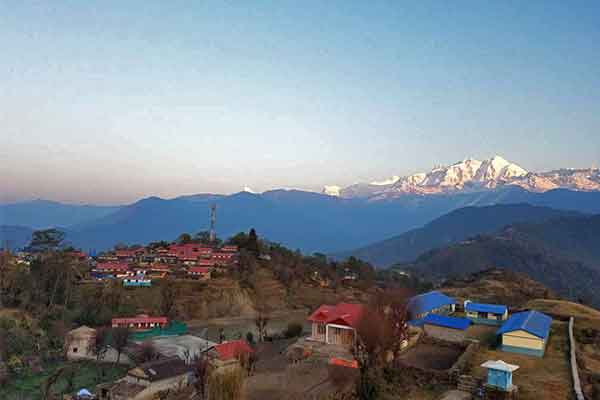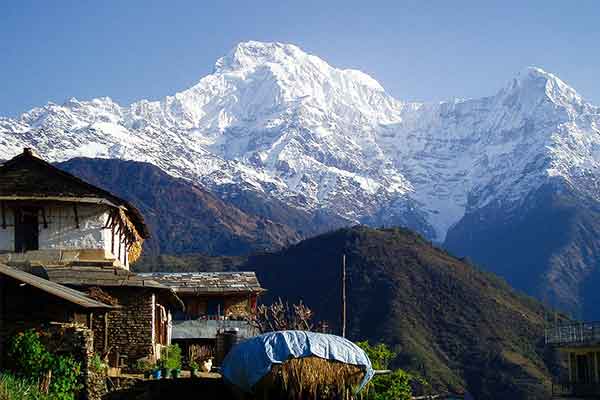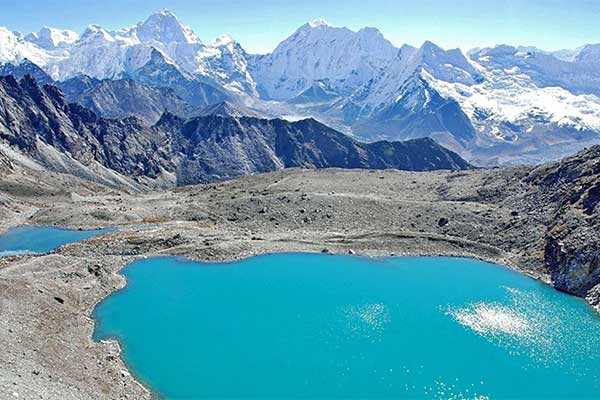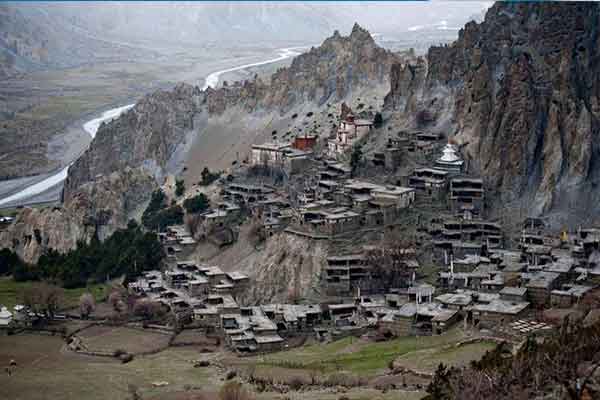Overview
Duration :
14 days
Secondary Activity:
Nature and Mix-Culture
Max altitude :
3244m/10643ft
Transportation:
Private Vehicle
Trip ends in:
Kathmandu
Accomodation:
Lodge and Hotel
Primary activity:
Trekking and Hiking
Group Size:
Min. 2 pax
Country:
Nepal
Trip starts from:
Kathmandu
Diffficulty:
Moderate
Meals:
Nepali and Continental
Best Season:
Autumn and Spring
Trip route:
Kathmandu-Samari Bhanjyang-Trishuli Bazar-Samari Bhanjyang-Katunje Bazar-Jharlang-Ganga jamunaand and return back in same route.
Trip introduction
Ganga Jamuna Gorkha Trek is a short and moderately graded excursion nearby Kathmandu in the Dhading district of Nepal. The main highlight of this trek is the two similar-looking twin waterfalls named Ganga and Jamuna. Along with attractive waterfalls, excellent views of Himalayan ranges including Langtang, Ganesh Himal, Manaslu, and even Annapurna ranges are visible with our own eyes.
We embark on Ganga Jamuna Gorkha Trek as we take a drive from Kathmandu. Here, along with enjoying the famous waterfall, we also can witness panoramic views of various Himalayan ranges. It is also the pilgrimage site where local people and devotees gather during the full moon of November month. Then, we trek towards Baseri and drive to the historical town of Gorkha for sightseeing around Gorkha durbar square.
Ganga Jamuna Gorkha Trek is usually organized with camping or homestay accommodation. During this short trek, anyone with an average fitness level who loves to travel can join a professional team of Nepal Mountain Trekkers. You can embark on this trek at any time of the year. Contact us for more information about this and/or any of our trips. Also, we are offering a special discount on this trek to promote tourism in Nepal in the year 2024/2025.
Special Note:
If this itinerary doesn’t suit your requirement or if you want to customize it, please feel free to contact us. This trek could be customized as per your required time frame and budget limits.
Overview
-
Day 1Arrival in Kathmandu [1,300m/4,264 ft]:
-
Day 2Kathmandu: Sightseeing and Trek Preparation:
-
Day 3Drive from Kathmandu to Samari Bhanjyang (1,250m/4,101ft) via Trishuli Bazaar (540m/1,771ft) by bus/private vehicle:
-
Day 4Samari Bhanjyang to Katunje Bazaar (765m/2,510ft):
-
Day 5Katunje Bazaar to Kintang Phedi (655m/2,149ft):
-
Day 6Kintang Phedi to Jharlang (1,500m/4,921ft):
-
Day 7Jharlang to Laba (1,750m/5,741ft):
-
Day 8Laba to Manyang Bhanjyang (2,934m/9,625ft):
-
Day 9Trek from Manyang Bhanjyang to Majhgaun (2,200m/7,217ft):
-
Day 10Trek from Majhgaun to Ganga Jamuna (3,244m/10,643):
-
Day 11Ganga Jamuna to Baseri (1,400m/4593ft):
-
Day 12Rest Day at Baseri:
-
Day 13Baseri to Gorkha (1,143m/3,750ft): 2 hrs. walk and 6-7 hrs drive:
-
Day 14Gorkha Durbar Sightseeing:
-
Day 15Drive from Gorkha to Kathmandu by bus:
-
Day 16Departure Day:
Detail Itinerary
Day 1 : Arrival in Kathmandu [1,300m/4,264 ft]::
Upon your arrival at the Tribhuvan International Airport for the breathtaking adventure ahead. You will be taken into your respective hotel and into your room so that you can relax your jet-lagged body. As tomorrow you get to go for a sightseeing tour of the Kathmandu valley, you will need to take some time to rest. Stay overnight in Kathmandu.
Day 2 : Kathmandu: Sightseeing and Trek Preparation::
A day dedicated to the exploration of the ancient and medieval capital city of Kathmandu, we shall explore the heritages listed in the UNESCO World Heritage Site List combining the Hindu and Buddhist pilgrimage sites as well as other historical sites and heritages. The Kathmandu Durbar Square is one of the three royal complexes in the Kathmandu valley with historical royal palaces and other sacred heritages. Pashupatinath Temple is a sacred Hindu Temple dedicated to the Hindu God Shiva with several other temples and cultural practices located at the bank of the holy Bagmati River. We shall also explore the Buddhist pilgrimage of Swayambhunath Stupa, also known as Monkey Temple due to the habitation of holy monkeys in the northwest area of the temple, and Boudhanath Stupa which is one of the largest and oldest stupas in the world. After exploring these heritages we shall have a pre-trip meeting in the afternoon with the trekking guide in the hotel. Here you can get the required information and an opportunity to clarify any doubts regarding any aspect of the trek. Stay overnight in Kathmandu.
Day 3 : Drive from Kathmandu to Samari Bhanjyang (1,250m/4,101ft) via Trishuli Bazaar (540m/1,771ft) by bus/private vehicle::
Depart Kathmandu early morning for a 7-hour drive to the hill town of Sole Bazaar. Today you trace the route taken by king Prithvi Narayan Shah on his invasion march to Kathmandu over two centuries ago. En route, you pass through Trishuli Bazaar, a small town that was once the hub for trekking in this region and is home to a small but interesting traditional bazaar. From here you travel along a gravel road until you reach Samari Bhanjyang. This is a picturesque drive as you can see the beautiful scenery of rice terraces, small gorges, and green hills. Samari Bhanjyang is a small town and it was a trading place in the past. Stay overnight at Samari Bhanjyang.
Day 4 : Samari Bhanjyang to Katunje Bazaar (765m/2,510ft)::
Trek from Samari Bhanjyang to Katunje Bazaar (765m.) which takes about six and half hours. In the beginning, you trek along a gradual descent path and then your trail turns uphill. Finally, you trek through flat land to reach your destination. En route, you pass different villages, forests covered with pine and rhododendron, farming terraces, small streams, and numerous green hills. There is a small market in Katunje and you can have a first glimpse of Ganesh Himal from here. Stay overnight at Katunje Bazaar.
Day 5 : Katunje Bazaar to Kintang Phedi (655m/2,149ft)::
In the beginning, the trail goes downhill until Lapang Besi. You then walk along the river bank until you reach Kintang Phedi. En route, you pass several traditional villages, farming terraces, fishing spots, and beautiful green hills. Kintang Phedi lies at the bank of Netrawati or Ankhu Khola (stream). There are a few typical houses, shops with minimal supplies, and terraces where local people grow potatoes and other food grains. Stay overnight at Kintang Phedi.
Day 6 : Kintang Phedi to Jharlang (1,500m/4,921ft)::
Trek from Kintang Phedi to Jharlang (1,500m.) and it takes about six hours. All the way you trek a gradual ascent path passing through several villages, farming terraces, and green hills. These villages are predominated by Tamang, Brahmin, and Chhetris respectively. Maize, millet, rice, wheat, buckwheat, and green vegetable are their staple food. Jharlang is a Tamang village. You find a government school and numerous typical houses. The main occupation of the locals is agriculture. Stay overnight at Jharlang.
Day 7 : Jharlang to Laba (1,750m/5,741ft)::
The trail goes gradually up and sometimes steeply up in the beginning. Towards the ending point, the trail moves downhill until Laba. En route, you pass villages, small gorges, small forests, farming terraces, and green hills. Laba is another village that you will encounter on this trek. It is inhabited by both Tamang and Gurung. You can observe the typical culture practiced by these ethnic communities. They even speak their own language. The visitors can taste the traditional food and local alcoholic drink (Chhyang). This trekking route is enriched with a distinct culture and unchanged traditions of ethnic groups like Tamang and Gurung. The potatoes grown in and around this area are famous all over Nepal. Stay overnight at Laba.
Day 8 : Laba to Manyang Bhanjyang (2,934m/9,625ft)::
Trek from Laba to Manyang Bhanjyang (2,934m.) and it takes about five hours. On this day you trek through beautiful rhododendron and pine forests. These forests are the home of various species of birds and wild animals. The trail moves uphill all the way to Manyang Bhanjyang. From here you can see the first glimpse of the Ganesh Himal. While trekking you pass Khading village mainly resided by Tamang and Gurung. The main crop is potato here. Manyang Bhanjyang is a ridge and you find forests and grassland here. This is a perfect place for camping as your camping site is surrounded by rhododendron and oak forests. Stay overnight at Manyang Bhanjyang.
Day 9 : Trek from Manyang Bhanjyang to Majhgaun (2,200m/7,217ft)::
To reach Majhgaun you have to trek along a gradually descending path and after some time a steeply descending path. On the way, you pass forests of rhododendron and oak, villages, farming terraces, and green hills. On this day you are quite captivated by the clear views of the Manaslu range, Buddha peak in clear weather, and other unnamed mountains and peaks. As you enter Majhgaun you will find local people being engaged in farming but it is reported that some of the people have migrated either to foreign countries or to Kathmandu. Stay overnight at Majhgaun.
Day 10 : Trek from Majhgaun to Ganga Jamuna (3,244m/10,643)::
Trek from Majhgaun to Ganga Jamuna (3,244m.) which takes about six hours. After descending for early few hours the trail turns steep ascent until you reach Ganga Jamuna. This is a Hindu pilgrimage site where a famous fair is held around the temple before three days of full moon day during the first week of November. Many Hindu devotees crowd this holy site for worship and blessing. Here is a holy stone that is highly revered by the Hindu devotees and local people. It is believed that this holy stone preserves the divine power as water originates from there. This place is perfect for camping. The panoramic views of the Langtang range, Ganesh Himal, Shringi Himal, Manaslu range, Lamjung Himal, Himalchuli, Annapurna range, and many other unnamed mountains and peaks completely mesmerize the you. Stay overnight at Ganga Jamuna.
Day 11 : Ganga Jamuna to Baseri (1,400m/4593ft)::
Trek from Ganga Jamuna to Baseri (1,900 m.) and it takes about four hours. This day’s trekking is full of ups and downs. All the way you pass through Mongolian villages. The mountain views you can enjoy are Manaslu Himal, and Ganesh Himal and you can see the green views of forest, hill, and Gandaki at some distance. Stay overnight at Baseri.
Day 12 : Rest Day at Baseri::
You are lucky that you are getting an additional day to explore Baseri Village. So, you will utilize the day as much as you can. As the village is known for homestays you can develop a good relationship with the host family and receive useful information. Stay overnight in the lodge at Baseri.
Day 13 : Baseri to Gorkha (1,143m/3,750ft): 2 hrs. walk and 6-7 hrs drive::
Trek from Baseri to Arughat Bazaar (1,000m.) which takes about four hours. To reach Arughat Bazaar you trek the descent path and then through leveled route. On the way, you pass a few streams, villages, farming terraces, and small forests. Most of the route moves along the riverbank of Budhi Gandaki. Aarughat Bazaar covers a small area with an old market. Here you find shops with minimal supply, a motorable road, a high school, a health post, typical tea houses, and small lodges and it lies at the bank of Budhi Gandaki River. Stay overnight at Gorkha.
Day 14 : Gorkha Durbar Sightseeing::
Gorkha is famous as the ancient capital of Nepal, the traditional homeland of the Royal family who unified Nepal with their awesome Gorkha soldiers who formed the basis of the famed Gorkha Regiment of the British Army. This day can be used as a rest day or if you prefer, you can spend it exploring the old palace, Gorkha Durbar. Perched 300m above the town, it is well worth the climb, with stunning views over the kingdom, including amazing Manaslu and Annapurna views. You can also take a circular half-day tour around town enjoying the stunning views out over Nepal. This is the mid-way point between Pokhara and Kathmandu but it is rarely visited by foreigners. It is a great spot to relax and have another night with hot showers in a hotel before getting back to camping and the rest of our journey. Stay overnight at Gorkha.
Day 15 : Drive from Gorkha to Kathmandu by bus::
It is a pleasant drive back to Kathmandu via beautiful Abu Khaireni town. While driving, you head up to Mugling and Kurintar where Nepal’s first Cable car is operated to reach Manakamana Temple. En route, you enjoy the mountain views, green sceneries, rice terrace fields, vegetable fields, and people being engaged in their daily life activities. From Naubishe you climb to Thankot, the gateway to the capital city. Stay overnight in Kathmandu.
Day 16 : Departure Day::
We are to the end of this journey that has taken us to the lap of the Himalayas and provided us the opportunity to get up close and personal with the Himalayas without being on strenuous altitudes. You will be accompanied by a representative of Nepal Mountain Trekkers Nepal as you are transferred to the Tribhuwan International Airport for your scheduled flight to the onward destination at least three hours prior to the scheduled time.
Price Includes
- Airport Pick-up and drop service
- 3 nights Hotel in Kathmandu(Hotel Green Horizon or similar standard)
- All accommodation during the trek in the best hotels/tea-houses in the area (differing according to the price you wish to spend)
- Sanitation: The accommodation we provide will be neat and clean with warm hospitality and quality services.
- Single Accommodation: You won’t have to share your accommodation with anyone else so your privacy is protected.
- All foods during the trek: Breakfast, Lunch, and Dinner; any items on the menu as much as you wish to consume.
- We provide hygienic and safe meals to re-energize you.
- We request you not waste your meals because it is difficult to transport food in the rural area.
- You are not allowed to share your meals with anyone else from another group.
- Domestic flights and airport departure taxes
- All required land transportation
- Professional and Highly experienced English-speaking Trekking Guide licensed by the Government. Including their lodging and food.
- Local Staff: Our guides are locals of the region which ensures that you will surely get to explore a bit more during the trek than with any other guides.
- Experienced: With the experience of more than a decade of working in this field, our trekking guides possess excellent knowledge on briefing during the trek. They are experts in handling all kinds of critical situations that might occur during the trek.
- Insurance: Nepal Mountain Trekkers have an insurance policy for all our trekking staff.
- Porters (1 porter for 2 trekkers with a max load of 25 KG). Including their lodging and food.
- Local Staff: The porters we hire belong to the same region where we trek to provide employment opportunities to the locals and make you explore every prospect of the region.
- Trekking permits: TIMS card, and National Parks Entrance Fees
- First aid medical box
- Four seasonal sleeping bags, down jacket, Nepal Mountain Trekkers duffer bag, t-shirt, and trekking map (Note: down jacket and sleeping bag are to be returned after trip completion)
- Rescue Arrangement Service
- 13% VAT and 10% company service charge
- Farewell Dinner
Price Excludes
- Nepal Entry Visa fee (Visa Information)
- International airfare and excess baggage charges
- Personal expenses (phone calls, laundry, bar bills, battery recharge, extra porters, bottle or boiled water, shower, etc)
- Travel Insurance/ Rescue Operation Cost
- Tips for guides and porters
Equipments
 Head
Head
- Sun hat or scarf
- Light balaclava or warm fleece hat
- Sunglasses
- Head Torch
 Upper Body
Upper Body
- Cotton t-shirts or thermals
- Fleece jacket
- Waterproof jacket
- Down jacket
 Lower Body
Lower Body
- Lightweight cotton pants (long)
- Waterproof pants
 Feet
Feet
- Thin inner socks
- Thick, warm wool hiking socks
- Comfortable hiking boots
 Hands
Hands
- Gloves
- Creams
 Accessories
Accessories
- Sleeping bag rated to -10°C +
- Trekking bag (Rucksack)
- Duffel bag
- Large plastic bags (for keeping items dry inside trek bag)
- Trekking poles (optional, recommended)
- Water bottle or camel bag
- Toiletries
Related Trips
You will also like …
